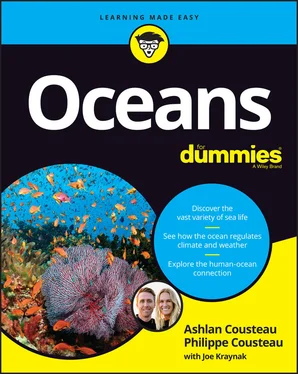Have you ever noticed when you’re near the ocean, you feel calmer? You feel a little healthier, less stressed, peaceful, and happier? Well, while part of that sense of serenity may be due to the fact that it’s the weekend or you’re on vacation, most of it is actually due to the fact that the ocean has a soothing and restorative effect on the mind and spirit. This is something that our friend and noted marine biologist Wallace J. Nichols explores in his book Blue Mind (Back Bay Books, 2015). In it Nichols explores neuroscience, evolutionary biology, and medical research to illuminate the physiological and brain processes that underlie our connection to water and its effects on the human body, mind, and spirit.
Through his research, Nichols found that being in or close to water, whether ocean, lake, stream, river, or even swimming pool, reduces anxiety, boosts creativity, strengthens human bonds, increases compassion, and even enhances job performance. As Nichols summarizes ( www.wallacejnichols.org/122/bluemind.html ), “Water is medicine for those who need it most … and everyone else,” a statement that resonates with Danish writer Isak Dinesen, who wrote, “The cure for anything is salt water: sweat, tears or the sea.”
Any way you slice it, we are all connected to the ocean and through the ocean to one another — physically through air and water, emotionally through stories, art and music, and mentally through our daydreams, whether they’re dreams of sitting near the beach with a cold drink as the sea blows gently through our hair, of standing tall on the deck of a wooden ship battling the kraken, or of being seduced by the siren songs of distant mermaids.
See you there.
Chapter 3
Looking Back at the Ocean’s History (and Prehistory)
IN THIS CHAPTER
 Considering a couple theories on how the ocean came to be
Considering a couple theories on how the ocean came to be
 Meeting a few of the ocean’s prior inhabitants
Meeting a few of the ocean’s prior inhabitants
 Checking the ocean’s current state and status
Checking the ocean’s current state and status
 Projecting the ocean’s future
Projecting the ocean’s future
You can understand a great deal about people, places, and things by examining their past. This is even more true of the ocean, which has at least a 3.8 billion-year history, give or take a few hundred million years. Now that’s a lot of birthdays! Over the course of its existence, it went quickly from mostly fresh water to salt water, has seen entire populations of plants and animals evolve and go extinct, and has been divided into oceans (plural) as huge land masses drifted apart. It is even thought to have frozen over at least twice and possibly as many as four times in its long history. (Don’t worry, the last freeze was about 600 million years ago, and the bigger problem now is global warming, not cooling.)
In this chapter, we transport you back in time to the birth of the ocean and trace its long history of supporting the evolution of various forms of marine life, a few of which you’ll meet up close and personal. We then fast-forward to the present to describe the current condition of the ocean and its inhabitants, along with the impact it has on Earth overall. We wrap things up by taking a peek into the possible future of the ocean to see where it may be heading. (This chapter gets wet, messy, and maybe a little hard to follow at times, so if you want to skip ahead, we would understand. But it’s also really cool, so we hope you stick with us.)
Discovering How the Ocean Got Its Start
Our ocean covers 71 percent of our planet and accounts for nearly 97 percent of its water. That may represent a mere drop in a bucket on a cosmic scale, but it’s respectable on a planetary scale.
If you had that much water in your basement, you’d want to know where it came from, and scientists have been trying to answer that question since, well, about the time they started asking questions. The two big questions are: Was that water always here? and if not, How the heck did it get here? These aren’t exactly “Which came first, the chicken or the egg?” questions, but they’re sort of along the same lines. Either water came from the space debris that formed Earth (so the makings of the ocean were here already), or water arrived via comets or asteroids crashing into Earth after it was already formed. ( Note:Comets are made of dust, rock, and ice, and they tend to fly farther from the sun than asteroids do. Asteroids are made mostly of metal and rock and varying amounts of water and tend to hang out closer to the sun. Meteors are comets that enter Earth’s atmosphere.)
In this section, we present the two leading theories of how all that water got here as we explore the ocean’s formation.
 Some scientists prefer one theory over the other, but most believe Earth’s water came from multiple sources. Most likely, Earth had some water baked into it during its formation, Earth produced its own water from hydrogen and oxygen, and water was delivered from space via comets and asteroids. That should make everybody happy.
Some scientists prefer one theory over the other, but most believe Earth’s water came from multiple sources. Most likely, Earth had some water baked into it during its formation, Earth produced its own water from hydrogen and oxygen, and water was delivered from space via comets and asteroids. That should make everybody happy.
The prevailing theory is that the water and/or the chemicals needed to make water were already here when Earth was formed. In other words, Earth formed as a “wet planet.” How planets are formed is also a subject of debate, but generally speaking, they form when particles of dust and gas clump together. In its early days, our solar system was a cloud of dust and gas (or clumps of dust and gas). Gravity caused the matter to collapse in on itself as it began to spin, forming the Sun at the center and the planets around it.
According to this theory, the ocean was formed when water (in the form of vapor) slowly escaped from Earth’s hot molten interior into the atmosphere surrounding the cooling planet. This degassing, as it’s called, occurred over millions of years. As the planet cooled to below the boiling point of water, the vapor slowly condensed into clouds and rain began to fall for centuries or even millennia. At some point, estimated at between 4.4 to 3.8 billion years ago, enough water had been wrung from the sky to create the primeval ocean.
The water delivery truck theory
The competing theory is that water came after Earth was fully formed. This theory asserts that thousands of watery/icy comets and asteroids containing hydroxide (a water precursor) delivered water to Earth. Back then, Jupiter was slightly closer to the sun, and its presence and gravity could have shifted the orbit of these comets and asteroids, putting them on a collision course with Earth. Heat from Earth and the sun melted the ice and formed the ocean.
To test whether Earth’s water came from comets or asteroids, scientists looked at the composition of the water itself. They compared the ratios of hydrogen isotopes (hydrogen atoms with slightly different nuclear masses) among water samples from Earth, asteroids, and comets. None of them matched exactly, but Earth’s water was more similar to that of water contained in asteroids.
Читать дальше

 Considering a couple theories on how the ocean came to be
Considering a couple theories on how the ocean came to be Some scientists prefer one theory over the other, but most believe Earth’s water came from multiple sources. Most likely, Earth had some water baked into it during its formation, Earth produced its own water from hydrogen and oxygen, and water was delivered from space via comets and asteroids. That should make everybody happy.
Some scientists prefer one theory over the other, but most believe Earth’s water came from multiple sources. Most likely, Earth had some water baked into it during its formation, Earth produced its own water from hydrogen and oxygen, and water was delivered from space via comets and asteroids. That should make everybody happy.










